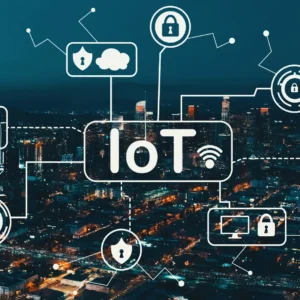- Made In INDIA

At its core, IoT is about connectivity – connecting devices, appliances, vehicles, and even entire cities to the internet, allowing them to collect and share data, automate processes, and enable intelligent decision-making. This technology has the potential to improve quality of life and transform virtually every aspect of our lives, from healthcare and transportation to agriculture and home automation. IoT has the potential to revolutionize industries and enhance efficiency. Let’s explore the concept of IoT, its applications, benefits, challenges, and the future outlook of this rapidly evolving technology.
At its core, IoT refers to a network of interconnected devices and objects that can communicate and share data without human intervention. These devices are embedded with sensors, actuators, and connectivity modules, allowing them to collect, transmit, and receive data over the internet. IoT encompasses a wide range of technologies, including smart home devices, industrial sensors, wearable gadgets, and autonomous vehicles.
The fundamental principle of IoT is connectivity and data exchange. By leveraging internet connectivity, devices can be remotely monitored, controlled, and optimized to improve efficiency, productivity, and convenience across various domains.
IoT has a profound impact on numerous industries, revolutionizing processes, and unlocking new possibilities for innovation. In the healthcare sector, IoT devices enable remote patient monitoring, personalized medicine, and predictive analytics for disease prevention. Smart home systems leverage IoT to automate household tasks, enhance security, and optimize energy usage.
In agriculture, IoT sensors monitor soil conditions, crop health, and weather patterns to optimize farming practices and increase yields. Industrial IoT (IIoT) facilitates predictive maintenance in manufacturing, enabling real-time monitoring of equipment performance and reducing downtime.
IoT also plays a critical role in transportation and logistics, powering connected vehicles, smart traffic management systems, and efficient supply chain operations.



The widespread adoption of IoT offers several key benefits across different sectors:
IoT and Smart Cities
The integration of IoT technology into urban infrastructure is enabling the development of smart cities. IoT sensors can be used to monitor traffic patterns, air quality, energy consumption, and public safety. This data can be leveraged to optimize city operations, reduce environmental impact, and improve the overall quality of life for residents.
IoT in Retail
The retail industry is embracing IoT to enhance the shopping experience and streamline operations. IoT-enabled inventory management systems, smart shelves, and real-time supply chain tracking are revolutionizing retail logistics. Additionally, IoT data analytics can provide valuable insights into consumer behavior, enabling personalized marketing and targeted promotions.
IoT and Sustainability
IoT plays a crucial role in promoting sustainability and environmental conservation efforts. IoT sensors can monitor resource consumption, energy usage, and waste management, enabling data-driven strategies to reduce carbon footprints and promote circular economies. Furthermore, IoT-enabled precision agriculture techniques can optimize water and fertilizer usage, minimizing waste and environmental impact.
IoT and Robotics
The convergence of IoT and robotics is paving the way for advanced automation and intelligent systems. IoT-enabled robots can leverage real-time data and analytics to perform complex tasks with greater efficiency and precision. This integration has applications in manufacturing, logistics, healthcare, and even domestic settings, where robots can assist with tasks such as cleaning, monitoring, and personal assistance.
IoT and Augmented Reality (AR)/Virtual Reality (VR)
The combination of IoT, AR, and VR technologies opens up new possibilities for immersive experiences and enhanced visualization. IoT data can be integrated into AR/VR environments, enabling real-time monitoring, remote control, and interactive simulations. This convergence has applications in fields such as remote maintenance, training, and product design.
IoT and Ethics
As IoT continues to pervade various aspects of our lives, ethical considerations surrounding data privacy, security, and the responsible use of these technologies become increasingly important. Discussions around data governance, consent, and the potential implications of widespread IoT adoption on individual rights and societal values are crucial for ensuring the ethical and sustainable development of IoT.





Despite its transformative potential, IoT adoption presents several challenges and considerations:
Looking ahead, the future of IoT promises further innovation and integration across industries:
In conclusion, the Internet of Things (IoT) represents a revolutionary shift in how we perceive and interact with technology. By connecting the world around us through intelligent devices and data-driven insights, IoT holds the potential to drive innovation, improve efficiency, and enhance quality of life on a global scale.
As IoT continues to evolve and mature, addressing challenges such as security, privacy, and interoperability will be paramount to realizing its full potential. With ongoing advancements in connectivity, computing capabilities, and data analytics, the IoT revolution is set to transform industries, empower individuals, and create a more connected and intelligent world.
©2024 Holoware® Computers Pvt. Ltd. | Privacy Policy | Terms & Condition
Roles & Responsibilities:
Preferred candidate profile:
Key Skills:
Location: Guindy & Porur
No of Openings: 3
Hindi Speaking is preferred
Fresher to 4 years experience in the relevant field is preferred.
Job description
We are seeking a motivated and detail-oriented Sales Coordinator to join our dynamic sales team. The Sales Coordinator will play a key role in supporting our sales representatives and ensuring smooth operations within the sales department. This position offers an exciting opportunity to contribute to the success of our sales initiatives and provide excellent customer service to our clients.
Role & responsibilities
Preferred candidate profile
Perks and benefits
Warranty Offers
Services with those steps are available
Solution With 24/7 Support
Get Started


In 1994, Mr.Thangavel started Origin Information Technology (in partnership with Mr. Loganathan) to provide quality computer hardware sales and service. In the year 2022, the company name was changed to “Tinkas Industries Private Limited” to encompass its diversified activities. Mr. Thangavel feels that he can give back to his nation the growth it needs in many ways like providing employment opportunities to many, and doing CSR activities, etc. His goal is to make Tinkas a leader at the National and Internaltional levels.
Holoware CEO abut Tinkas CEO
“The CEO of Tinkas (Mr.Thangavel) is undeniably one of the most practical and resourceful individuals I’ve encountered in Tamil Nadu. His profound understanding of the industry coupled with his diverse business ventures truly exemplifies his wealth of knowledge. Partnering with Tinkas has been a delight, and we eagerly anticipate further growth and collaboration.”
Mr. Ketan Patel is an indomitable entrepreneur revolutionizing the landscape of electronic consumer products worldwide through an unparalleled ‘experiential journey.’ Leading Creative Newtech since 1992, he steered its growth from a Mumbai market trader to a distributor and Brand Licensee. As an alumnus of IIM-Bangalore, Mr Patel leads Creative Newtech with a focus on innovation and strategic leadership. Under his three-decade leadership, Creative Newtech has become India’s market leader, expanding globally across Hong Kong, the Middle East, and the SAARC region.”
Holoware CEO abut Creative Newtech CEO
“The CEO of Creative (Mr.Ketan Patel) is a highly knowledgeable leader, renowned for his expertise in distributorship. His intuitive knack for product selection and sales strategies, both in India and abroad, is impressive. Creative thrives as a powerhouse, fueled by its diverse team and collective expertise. We eagerly look forward to a promising future and further success in our collaboration with Creative.”


Inmac Computers Private Limited is a trailblazing name in the realm of IT services and solutions. With a remarkable inception in 1992 by visionary entrepreneurs Girish Babu and Asha Girish Babu, our company has consistently remained at the forefront of technological innovation, setting new standards for excellence in the industry.
Holoware CEO abut Inmac CEO
“Inmac’s CEO (Mr.Girish Babu) is one of the most humble and generous individuals I’ve ever had the pleasure of meeting. His leadership has been instrumental in steering his team to success, not just in Maharashtra but across various regions in India. Their financial stability over the years speaks volumes about his capabilities. It’s truly a delight to collaborate with someone of his caliber. I look forward to continued partnership with Inmac.”